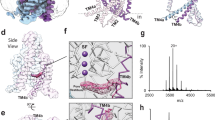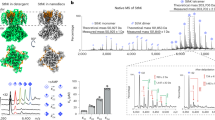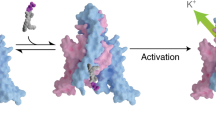Abstract
A fundamental question about the gating mechanism of voltage-activated K+ (Kv) channels is how five positively charged voltage-sensing residues1,2 in the fourth transmembrane segment are energetically stabilized, because they operate in a low-dielectric cell membrane. The simplest solution would be to pair them with negative charges3. However, too few negatively charged channel residues are positioned for such a role4,5. Recent studies suggest that some of the channel’s positively charged residues are exposed to cell membrane phospholipids and interact with their head groups5,6,7,8,9. A key question nevertheless remains: is the phospho-head of membrane lipids necessary for the proper function of the voltage sensor itself? Here we show that a given type of Kv channel may interact with several species of phospholipid and that enzymatic removal of their phospho-head creates an insuperable energy barrier for the positively charged voltage sensor to move through the initial gating step(s), thus immobilizing it, and also raises the energy barrier for the downstream step(s).
This is a preview of subscription content, access via your institution
Access options
Subscribe to this journal
Receive 51 print issues and online access
$199.00 per year
only $3.90 per issue
Buy this article
- Purchase on Springer Link
- Instant access to full article PDF
Prices may be subject to local taxes which are calculated during checkout




Similar content being viewed by others
References
Aggarwal, S. K. & MacKinnon, R. Contribution of the S4 segment to gating charge in the Shaker K+ channel. Neuron 16, 1169–1177 (1996)
Seoh, S. A., Sigg, D., Papazian, D. M. & Bezanilla, F. Voltage-sensing residues in the S2 and S4 segments of the Shaker K+ channel. Neuron 16, 1159–1167 (1996)
Armstrong, C. M. Sodium channels and gating currents. Physiol. Rev. 61, 644–683 (1981)
Papazian, D. M. et al. Electrostatic interactions of S4 voltage sensor in Shaker K+ channel. Neuron 14, 1293–1301 (1995)
Long, S. B., Campbell, E. B. & MacKinnon, R. Voltage sensor of Kv1.2: structural basis of electromechanical coupling. Science 309, 903–908 (2005)
Cuello, L. G., Cortes, D. M. & Perozo, E. Molecular architecture of the KvAP voltage-dependent K+ channel in a lipid bilayer. Science 306, 491–495 (2004)
Freites, J. A., Tobias, D. J., von Heijne, G. & White, S. H. Interface connections of a transmembrane voltage sensor. Proc. Natl Acad. Sci. USA 102, 15059–15064 (2005)
Ramu, Y., Xu, Y. & Lu, Z. Enzymatic activation of voltage-gated potassium channels. Nature 442, 696–699 (2006)
Schmidt, D., Jiang, Q. X. & MacKinnon, R. Phospholipids and the origin of cationic gating charges in voltage sensors. Nature 444, 775–779 (2006)
Glenny, A. T. & Stevens, N. F. Staphylococcal toxins and antitoxins. J. Pathol. Bacteriol. 40, 201–210 (1935)
McNamara, P. J., Cuevas, W. A. & Songer, J. G. Toxic phospholipases D of Corynebacterium pseudotuberculosis, C. ulcerans and Arcanobacterium haemolyticum: cloning and sequence homology. Gene 156, 113–118 (1995)
Kurpiewski, G., Forrester, L. J., Barrett, J. T. & Campbell, B. J. Platelet aggregation and sphingomyelinase D activity of a purified toxin from the venom of Loxosceles reclusa . Biochim. Biophys. Acta 678, 467–476 (1981)
Doery, H. M., Magnusson, B. J., Cheyne, I. M. & Sulasekharam, J. A phospholipase in staphylococcal toxin which hydrolyses sphingomyelin. Nature 198, 1091–1092 (1963)
Read, T. D. et al. The genome sequence of Bacillus anthracis Ames and comparison to closely related bacteria. Nature 423, 81–86 (2003)
Projan, S. J. et al. Nucleotide sequence: the β-hemolysin gene of Staphylococcus aureus . Nucleic Acids Res. 17, 3305 (1989)
Kilsdonk, E. P. et al. Cellular cholesterol efflux mediated by cyclodextrins. J. Biol. Chem. 270, 17250–17256 (1995)
Lu, Z., Klem, A. M. & Ramu, Y. Ion conduction pore is conserved among potassium channels. Nature 413, 809–813 (2001)
Swartz, K. J. & MacKinnon, R. Mapping the receptor site for hanatoxin, a gating modifier of voltage-dependent K+ channels. Neuron 18, 675–682 (1997)
Phillips, L. R. et al. Voltage-sensor activation with a tarantula toxin as cargo. Nature 436, 857–860 (2005)
Swartz, K. J. & MacKinnon, R. Hanatoxin modifies the gating of a voltage-dependent K+ channel through multiple binding sites. Neuron 18, 665–673 (1997)
Armstrong, C. M. & Bezanilla, F. Currents related to movement of the gating particles of the sodium channels. Nature 242, 459–461 (1973)
Hoshi, T., Zagotta, W. N. & Aldrich, R. W. Biophysical and molecular mechanisms of Shaker potassium channel inactivation. Science 250, 533–538 (1990)
Kitaguchi, T., Sukhareva, M. & Swartz, K. J. Stabilizing the closed S6 gate in the Shaker Kv channel through modification of a hydrophobic seal. J. Gen. Physiol. 124, 319–332 (2004)
Schoppa, N. E., McCormack, K., Tanouye, M. A. & Sigworth, F. J. The size of gating charge in wild-type and mutant Shaker potassium channels. Science 255, 1712–1715 (1992)
Loboda, A. & Armstrong, C. M. Resolving the gating charge movement associated with late transitions in K channel activation. Biophys. J. 81, 905–916 (2001)
DeCoursey, T. E., Chandy, K. G., Gupta, S. & Cahalan, M. D. Voltage-gated K+ channels in human T lymphocytes: a role in mitogenesis? Nature 307, 465–468 (1984)
Matteson, D. R. & Deutsch, C. K+ channels in T lymphocytes: a patch clamp study using monoclonal antibody adhesion. Nature 307, 468–471 (1984)
Chandy, K. G. et al. K+ channels as targets for specific immunomodulation. Trends Pharmacol. Sci. 25, 280–289 (2004)
Perozo, E., MacKinnon, R., Bezanilla, F. & Stefani, E. Gating currents from a nonconducting mutant reveal open-closed conformations in Shaker K+ channels. Neuron 11, 353–358 (1993)
Ramu, Y., Xu, Y. & Lu, Z. Inhibition of CFTR Cl-channel function caused by enzymatic hydrolysis of sphingomyelin. Proc. Natl Acad. Sci. USA 104, 6448–6453 (2007)
Swartz, K. J. & MacKinnon, R. An inhibitor of the Kv2.1 potassium channel isolated from the venom of a Chilean tarantula. Neuron 15, 941–949 (1995)
Acknowledgements
We thank S. Billington for sharing SMase D cDNA; C. Deutsch for Kv1.3 cDNA; K. Ho and S. Hebert for Kir1.1; R. Joho for Kv2.1 cDNA; K. Swartz for Shaker-V478W cDNA; C. Armstrong for comments on the manuscript; and P. De Weer for review and discussion of the manuscript. This study was supported by a grant from the National Institute of General Medical Sciences to Z.L.
Author information
Authors and Affiliations
Corresponding author
Rights and permissions
About this article
Cite this article
Xu, Y., Ramu, Y. & Lu, Z. Removal of phospho-head groups of membrane lipids immobilizes voltage sensors of K+ channels. Nature 451, 826–829 (2008). https://doi.org/10.1038/nature06618
Received:
Accepted:
Issue Date:
DOI: https://doi.org/10.1038/nature06618
This article is cited by
-
Tracking Membrane Protein Dynamics in Real Time
The Journal of Membrane Biology (2021)
-
A PIP2 substitute mediates voltage sensor-pore coupling in KCNQ activation
Communications Biology (2020)
-
TRP Channels, Conformational Flexibility, and the Lipid Membrane
The Journal of Membrane Biology (2020)
-
Dual mass spectrometry as a tool to improve annotation and quantification in targeted plasma lipidomics
Metabolomics (2020)
-
Structural and functional characterization of protein–lipid interactions of the Salmonella typhimurium melibiose transporter MelB
BMC Biology (2018)
Comments
By submitting a comment you agree to abide by our Terms and Community Guidelines. If you find something abusive or that does not comply with our terms or guidelines please flag it as inappropriate.



